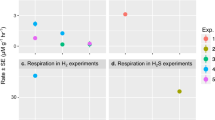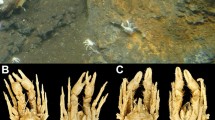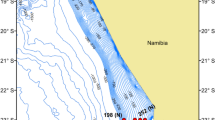Abstract
The primary base of the food chain of the dense animal populations found clustered around deep-sea hydrothermal vents1,2 appears to be chemoautotrophic bacteria, whose energy source is geothermally reduced hydrogen sulphide emitted from the vents3,4. Recently, a symbiotic association has been postulated5 between chemoautotrophic sulphur-oxidizing bacteria and the vent tubeworm, Riftia pachyptila Jones (phylum Pogonophora) on the basis of histological5 and enzymatic6 evidence. Hydrothermal vents thus appear to be a spectacular example of the role of reduced inorganic elements in animal nutrition. Marine muds and salt marsh sediments also produce a continuous supply of reduced sulphur compounds7,8, so the possibility arises that they support similar symbiotic associations5,9. I now present microscopic, enzymatic, and physiological evidence for the occurrence of intracellular sulphur-oxidizing chemoautotrophic bacteria in a bivalve, Solemya velum Say (phylum Mollusca), found in reducing muds of eelgrass beds. Bacterial symbionts were also observed in other animals from a variety of sulphide-rich habitats. It thus seems that symbiotic relationships with bacteria are widespread among sulphide-habitat marine invertebrates, and may have a significant role in their nutrition.
This is a preview of subscription content, access via your institution
Access options
Subscribe to this journal
Receive 51 print issues and online access
$199.00 per year
only $3.90 per issue
Buy this article
- Purchase on SpringerLink
- Instant access to full article PDF
Prices may be subject to local taxes which are calculated during checkout
Similar content being viewed by others
References
Corliss, J. B. et al. Science 203, 1073–1083 (1979).
RISE Project Group Science 207, 1421–1432 (1980).
Jannasch, H. W. & Wirsen, C. O. Bioscience 29, 592–598 (1979).
Ruby, E. G., Wirsen, C. O. & Jannasch, H. W. Appl. envir. Microbiol. 42, 317–324 (1981).
Cavanaugh, C. M., Gardiner, S. L., Jones, M. L., Jannasch, H. W. & Waterbury, J. B. Science 213, 340–342 (1981).
Felbeck, H. Science 213, 336–338 (1981).
Jorgensen, B. B. Nature 296, 643–645 (1982).
Howarth, R. W. & Teal, J. M. Limnol. Oceanogr. 24, 999–1013 (1979).
Cavanaugh, C. M. Biol. Bull. mar. biol. lab., Woods Hole 159, 457 (1980).
Stanley, S. M. Geol. Soc. Am. Mem. 125, 119–121, 132–133 (1970).
Blackwell, J. F., Gainey, L. F. Jr & Greenberg, M. J. Biol. Bull. mar. biol. lab., Woods Hole 152, 1–11 (1977).
McFadden, B. A. Bact. Rev. 37, 289–319 (1973).
Hobbie, J. E., Daley, R. J. & Jasper, S. Appl. envir. Microbiol. 33, 1225–1228 (1977).
Watson, S. W., Novitsky, T. J., Quinby, H. L. & Valois, F. W. Appl. Microbiol. 33, 940–946 (1977).
Sprent, J. I. in The Biology of Nitrogen-Fixing Organisms (European Plant Biology Series) 13–26 (McGraw-Hill, New York, 1979).
Bailey, J. E. & Ollis, D. F. in Biochemical Engineering Fundamentals, 70 (McGraw-Hill, New York, 1977).
Beudeker, R. F., Cannon, G. C., Kuenen, J. G. & Shively, J. M. Archs Mikrobiol. 124, 185–189 (1977).
Felbeck, H., Childress, J. J. & Somero, G. N. Nature 293, 291–293 (1981).
Southward, A. J. et al. Nature 293, 616–620 (1981).
Giere, O., Liebezeit, G. & Dawson, R. Mar. Ecol. Prog. Ser. 8, 291–299 (1982).
Jones, M. L. Science 213, 333–336 (1979).
Reid, R. G. B. & Bernard, F. R. Science 208, 609–610 (1980).
Boss, K. J. & Turner, R. D. Malacologia 20, 161–194 (1980).
Allen, J. A. Phil. Trans. R. Sci. B241, 421–484 (1958).
Howarth, R. W., Giblin, A., Gale, J., Peterson, B. J. & Luther, G. W. III, in Environmental Biogeochemistry (ed. Hallberg, R. O.) (Ecological Bulletin, Stockholm, in the press).
Waterbury, J. B. & Stanier, R. Y. Microbiol. Rev. 42, 2–44 (1978).
van der Land, J. & Norrevang, A. Biol. Skr. 21, 1–102 (1977).
Lonsdale, P. Nature 281, 531–534 (1979).
Emery, K. O. & Hulsemann, J. Deep-Sea Res. 8, 165–180 (1962).
Author information
Authors and Affiliations
Rights and permissions
About this article
Cite this article
Cavanaugh, C. Symbiotic chemoautotrophic bacteria in marine invertebrates from sulphide-rich habitats. Nature 302, 58–61 (1983). https://doi.org/10.1038/302058a0
Received:
Accepted:
Issue Date:
DOI: https://doi.org/10.1038/302058a0



